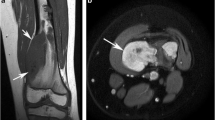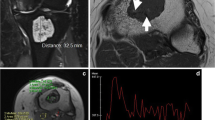Abstract
Objectives
To identify magnetic resonance imaging (MRI) features which differentiate low-grade chondral lesions (atypical cartilaginous tumours/grade 1 chondrosarcoma) from high-grade chondrosarcomas (grade 2, grade 3 and dedifferentiated chondrosarcoma) of the major long bones.
Methods
We identified all patients treated for central atypical cartilaginous tumours and central chondrosarcoma of major long bones (humerus, femur, tibia) over a 13-year period. The MRI studies were assessed for the following features: bone marrow oedema, soft tissue oedema, bone expansion, cortical thickening, cortical destruction, active periostitis, soft tissue mass and tumour length. The MRI-features were compared with the histopathological tumour grading using univariate, multivariate logistic regression and receiver operating characteristic curve (ROC) analyses.
Results
One hundred and seventy-nine tumours were included in this retrospective study. There were 28 atypical cartilaginous tumours, 79 grade 1 chondrosarcomas, 36 grade 2 chondrosarcomas, 13 grade 3 chondrosarcomas and 23 dedifferentiated chondrosarcomas. Multivariate analysis demonstrated that bone expansion (P = 0.001), active periostitis (P = 0.001), soft tissue mass (P < 0.001) and tumour length (P < 0.001) were statistically significant differentiating factors between low-grade and high-grade chondral lesions with an area under the ROC curve of 0.956.
Conclusions
On MRI, bone expansion, active periostitis, soft tissue mass and tumour length can reliably differentiate high-grade chondrosarcomas from low-grade chondral lesions of the major long bones.
Key Points
• Accurate differentiation of low-grade from high-grade chondrosarcomas is essential before surgery
• MRI can reliably differentiate high-grade from low-grade chondrosarcomas of long bone
• Differentiating features are bone expansion, periostitis, soft tissue mass and tumour length
• Presence of these four MRI features demonstrated a diagnostic accuracy (AUC) of 95.6 %
• The findings may result in more accurate diagnosis before definitive surgery







Similar content being viewed by others
References
Hogendoorn PCW, Bovee JM, Nielsen GP (2013) Chondrosarcoma (grades I-III), including primary and secondary variants and periosteal chondrosarcoma. In: Fletcher CDM, Bridge JA, Hogendoorn PCW, Mertens F (eds) World Health Organization Classification of Tumours of Soft Tissue and Bone. IARC Press, Lyon, pp 264–268
Inwards CHP (2013) In: Fletcher CDM, Bridge JA, Hogendoorn PCW, Mertens F (eds) World Health Organization Classification of Tumours of Soft Tissue and Bone. IARC Press, Lyon, pp 269–270
Grimer RJ, Carter SR, Tillman RM, Mangham DC, Abudu A, Fiorenza F (2000) Chondrosarcoma of bone. J Bone Joint Surg Am 82-A:1203–1204
Lee FY, Mankin HJ, Fondren G et al (1999) Chondrosarcoma of bone: an assessment of outcome. J Bone Joint Surg Am 81:326–338
Campanacci DA, Scoccianti G, Franchi A et al (2013) Surgical treatment of central grade 1 chondrosarcoma of the appendicular skeleton. J Orthop Traumatol 14:101–107
Donati D, Colangeli S, Colangeli M, Di Bella C, Bertoni F (2010) Surgical treatment of grade I central chondrosarcoma. Clin Orthop Relat Res 468:581–589
Hanna SA, Whittingham-Jones P, Sewell MD et al (2009) Outcome of intralesional curettage for low-grade chondrosarcoma of long bones. Eur J Surg Oncol 35:1343–1347
Verdegaal SH, Brouwers HF, van Zwet EW, Hogendoorn PC, Taminiau AH (2012) Low-grade chondrosarcoma of long bones treated with intralesional curettage followed by application of phenol, ethanol, and bone-grafting. J Bone Joint Surg Am 94:1201–1207
Skeletal Lesions Interobserver Correlation among Expert Diagnosticians (SLICED) Study Group (2007) Reliability of histopathologic and radiologic grading of cartilaginous neoplasms in long bones. J Bone Joint Surg Am 89:2113–2123
Murphey MD, Walker EA, Wilson AJ, Kransdorf MJ, Temple HT, Gannon FH (2003) From the archives of the AFIP: imaging of primary chondrosarcoma: radiologic-pathologic correlation. Radiographics 23:1245–1278
Hudson TM, Chew FS, Manaster BJ (1982) Radionuclide bone scanning of medullary chondrosarcoma. AJR Am J Roentgenol 139:1071–1076
Yoo HJ, Hong SH, Choi JY et al (2009) Differentiating high-grade from low-grade chondrosarcoma with MR imaging. Eur Radiol 19:3008–3014
De Beuckeleer LH, De Schepper AM, Ramon F (1996) Magnetic resonance imaging of cartilaginous tumors: is it useful or necessary? Skeletal Radiol 25:137–141
Geirnaerdt MJ, Bloem JL, Eulderink F, Hogendoorn PC, Taminiau AH (1993) Cartilaginous tumors: correlation of gadolinium-enhanced MR imaging and histopathologic findings. Radiology 186:813–817
De Beuckeleer LH, De Schepper AM, Ramon F, Somville J (1995) Magnetic resonance imaging of cartilaginous tumors: a retrospective study of 79 patients. Eur J Radiol 21:34–40
Janzen L, Logan PM, O'Connell JX, Connell DG, Munk PL (1997) Intramedullary chondroid tumors of bone: correlation of abnormal peritumoral marrow and soft-tissue MRI signal with tumor type. Skeletal Radiol 26:100–106
Varma DG, Ayala AG, Carrasco CH, Guo SQ, Kumar R, Edeiken J (1992) Chondrosarcoma: MR imaging with pathologic correlation. Radiographics 12:687–704
Evans HL, Ayala AG, Romsdahl MM (1977) Prognostic factors in chondrosarcoma of bone: a clinicopathologic analysis with emphasis on histologic grading. Cancer 40:818–831
Dahlin DC, Beabout JW (1971) Dedifferentiation of low-grade chondrosarcomas. Cancer 28:461–466
Enneking WF (1986) A system of staging musculoskeletal neoplasms. Clin Orthop Relat Res 204:9–24
Douis H, Saifuddin A (2012) The imaging of cartilaginous bone tumours. I. Benign lesions. Skeletal Radiol 41:1195–1212
Eefting D, Schrage YM, Geirnaerdt MJ et al (2009) Assessment of interobserver variability and histologic parameters to improve reliability in classification and grading of central cartilaginous tumors. Am J Surg Pathol 33:50–57
Geirnaerdt MJ, Hermans J, Bloem JL et al (1997) Usefulness of radiography in differentiating enchondroma from central grade 1 chondrosarcoma. AJR Am J Roentgenol 169:1097–1104
Geirnaerdt MJ, Hogendoorn PC, Bloem JL, Taminiau AH, van der Woude HJ (2000) Cartilaginous tumors: fast contrast-enhanced MR imaging. Radiology 214:539–546
Weiner SD (2004) Enchondroma and chondrosarcoma of bone: clinical, radiologic, and histologic differentiation. Instr Course Lect 53:645–649
Akcnowledgment
The images of the patients in Figs. 1 and 3 have been previously published by us in the following article: The imaging of cartilaginous bone tumours. II. Chondrosarcoma. Douis H, Saifuddin A. Skeletal Radiol. 2013 May;42(5):611-26
We have to emphasize however that the images are not exactly the same and that we either used a different slice position or a different MRI-sequence. Therefore, these exact images have not been previously published. We have nevertheless obtained permission from the publisher Springer to reprint the images.
Author information
Authors and Affiliations
Corresponding author
Rights and permissions
About this article
Cite this article
Douis, H., Singh, L. & Saifuddin, A. MRI differentiation of low-grade from high-grade appendicular chondrosarcoma. Eur Radiol 24, 232–240 (2014). https://doi.org/10.1007/s00330-013-3003-y
Received:
Accepted:
Published:
Issue Date:
DOI: https://doi.org/10.1007/s00330-013-3003-y




